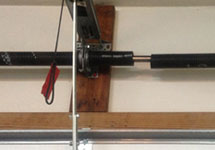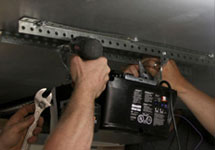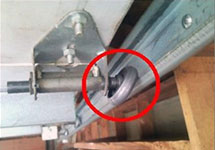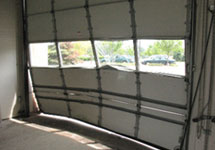
If leaves, rain, and dirt are seeping into your garage, it’s time to replace your garage door seal, and this is the perfect place to start. This handy guide will cover everything you need to know about the different types of garage door seals available. For the more hands-on reader, we’ll even walk you through how to install a new garage door seal step-by-step.
Types of Garage Door Seals
You might be wondering if garage door seals are universal. Unfortunately, the answer is no; it’s not quite that easy. Garage doors come in all shapes and sizes, and as such, there is no one size fits all solution. That said, for whatever type of garage door you have, there is a perfect garage door seal solution available! In understanding the different types of seals, you will be able to determine which one will be the best fit for your garage door! Of course, if you’d rather have a professional do the job, the experts at The Door Company in Northern California are here and ready to help!
Bottom Seals
Chances are that when you think of your garage door seal, you are probably picturing a bottom seal. The bottom seal is the primary seal that runs along the bottom of your garage door. Bottom seals are typically either rubber or vinyl, and their purpose is to prevent water, leaves, dirt, or whatever else from getting into your garage from outside. There are a few different garage door bottom seal types that you might encounter, the most common ones being J-type seals, T-type seals, bulbs, and beaded seals.
J-type and T-type seals get their name from their shape. When your garage door is closed, a J-type seal looks like two inverted letter J’s, whereas the T-type, you guessed it, looks like an upside-down letter T. Both of these types of seals, along with bulb type seals, may be used when a garage door has a single retainer track. Beaded type seals, on the other hand, are designed for doors with a double retainer.
Although the bottom seal is arguably the most important seal on a garage door, there are some other types of seals that you should know about.
Side Seals
Dirt and debris can get into your garage through the sides of the door if not sealed properly, and like with bottom seals, there are a few different types of side seals available.
A vinyl door stop is essentially a piece of plastic which ones parallel to the sides of your garage door. They can be great for keeping water out during heavier rains.
If heavy rain is not a major concern, then brush seals might be the perfect solution. These seals are just what they sound like. They’re brushes that run along the sides of your garage door, and they do a great job of preventing dust and debris from getting into your garage.
Reverse angle mount type seals can be used to seal the sides of your garage door. These seals are essentially hardened strips of plastic that run along with the frame of your garage door. They can be a great solution, especially for commercial properties, due to their durability.
Threshold Seals
Last but not least, threshold seals are a type of seal attached directly to your garage floor. These seals work in tandem with your bottom seal to add an additional layer of protection from the elements.
In most cases, the best solution will likely include having a bottom seal along with a threshold seal and side seals.

How to Replace your Garage Door Seal
Now that you understand more about the different types of garage door seals and what each one does, you can proceed with the installation. Be sure to measure your garage door before purchasing your new seal to ensure that you buy the appropriate length seal. The last thing you want is to come up a few inches short because having such a gap would largely defeat the purpose of installing a new seal in the first place. Let’s dive into how to properly install your own garage door seal.
Step 1 – Remove the Old Seal
To install your new seal, you will, of course, need to remove the old seal first. Some people find this part a bit frustrating, but it doesn’t have to be. Look at the retainer track and check if any screws are holding the seal in place. If there are screws, remove them first; if not, you can proceed with sliding the seal out of the retainer.
A utility knife can be handy when doing this. Gently pry the seal away from the retaining track. Take your time with this. You wouldn’t be the first person who tried to rip the old seal off, only to pinch their fingers in the retaining track. Once the seal starts to come away from the retainer track, it will be easy and straightforward to remove.
Step 2 – Prepare the Retainer
Next, it’s essential that you clean out the retainer track to get rid of any dust or dirt before installing the new seal. This is important because any dirt in the retainer track will prevent the new seal from sitting flush, which can compromise the effectiveness of the seal over time.
Soap and water should be fine as long as you make sure to dry the retainer before proceeding with the installation. A commercial cleaner will also do the trick; just make sure it isn’t harmful to your garage door.
Step 3 – Install the New Seal
The actual installation for a bottom seal is relatively easy. Simply feed the new seal through and along the retaining track and re-install the screws if there were any. Should you happen to have a double retainer, this part of the process might take a little longer. Take your time, be patient and just make sure that the seal remains flush against the retainer.
Having a partner can make the task much easier, but it is possible to do it by yourself; it just means that you will need to keep going back and feeding the seal through the retainer as you move along. Once you reach the end of the retainer, simply fold any excess material back into the track.
That’s it. All that’s left to do now is clean up the area, recycle your old seal, and give yourself a pat on the back for a job well done.
Find a Quality Contractor
If you are interested in replacing your garage door seal, choose an experienced contractor that is IDEA Certified and has Door Dealer Accreditation. The Door Company is a premier garage door and driveway gate company in California with locations in Chico, Yuba City, Redding, and Stockton. Talk to a representative today!



